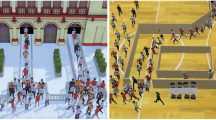Abstract
Based on trajectory planning with maximum velocity and acceleration constraints, a novel high-quality trajectory planning method was proposed for heterogeneous individuals in crowd simulation. The proposed method ensured that the individual’s path was smooth and its velocity was continuous. Based on the physiological constraints of humans with maximum velocity and acceleration, time-optimal trajectory and feasible region were derived by solving kinodynamic planning problem. Subsequently, a high-quality trajectory planning algorithm was designed to compute the trajectory with appropriate variation of velocity. The simulation results demonstrate that the proposed trajectory planning method has more authenticities and can generate high-quality trajectories for virtual humans in crowd simulation.
摘要
基于具有最大速度和最大加速度约束的轨迹规划方法,针对人群仿真中的异质群体,提出一种 新颖的高质量轨迹规划方法。该方法能够保证个体的运动路径是平滑的,个体的速度是连续的。考虑 到真实人具有最大速度和最大加速度的生理学约束,本文首先推导出一种时间最优的轨迹和可行域来 解决kinodynamic规划问题。随后,通过计算具有恰当速度多样性的轨迹设计出一种高质量的轨迹规 划方法。仿真结果表明提出的轨迹规划方法具有更高的真实性,能够为人群仿真中的虚拟人提供高质 量的运动轨迹。
Similar content being viewed by others
References
XUE Zhu-xin, DONG Qing, FAN Xiang-tao, JIN Qing-wen, JIAN Hong-deng, LIU Jian. Fuzzy logic-based model that incorporates personality traits for heterogeneous pedestrians [J]. Symmetry-Basel, 2017, 9(10). DOI: https://doi.org/10.3390/sym9100239.
LE P T, HOANG H V, SANG H A, SEUNG G L, DONG H K, TAE C C. Univector field method-based multi-agent navigation for pursuit problem in obstacle environments [J]. Journal of Central South University, 2017, 24(4): 1002–1012. DOI: https://doi.org/10.1007/s11771-017-3502-0.
XU Ming-liang, LI Chao-chao, LV Pei, CHEN Wei, DINESH M, DENG Zhi-gang, ZHOU Bing. Crowd simulation model integrating physiology-psychology-physics factors [J]. Computing Research Repository (CoRR), 2018, 18(1): 1–14. https://dblp.uni-trier.de/pers/hd/x/Xu:Mingliang,2018-08-1/.
BELLOMO N, CLARKE D, GIBELLI L, TOWNSEND P, VREUGDENHIL B J. Human behaviours in evacuation crowd dynamics: From modelling to big data toward crisis management [J]. Physics of Life Reviews, 2016, 18: 1–21. DOI: https://doi.org/10.1016/j.plrev.2016.05.014.
CHOSET H M, HUTCHINSON S, LYNCH K M, KANTOR G, BURGARD W, KAVRAKI L E, THRUN S. Principles of robot motion: Theory, algorithms, and implementations [M]. MIT Press, 2005.
NARANG S, BEST A, FENG A, KANG S H, MANOCHA D. Motion recognition of self and others on realistic 3D avatars [J]. Computer Animation and Virtual Worlds, 2017, 28(3, 4): e1762. DOI: https://doi.org/10.1002/cav.1762.
KAPADIA M, PELECHANO N, ALLBECK J. Virtual crowds: Steps toward behavioral realism [M]. Synthesis Lectures on Visual Computing: Morgan & Claypool Publishers, 2015.
LI Meng, LIANG Jia-hong, LI Shi-lei. Flocking behavior with multiple leaders and global trajectory [J]. Journal of Central South University, 2014, 21(6): 2324–2333. DOI: https://doi.org/10.1007/s11771-014-2184-0.
WALLAR A, PLAKU E. Path planning for swarms by combining probabilistic roadmaps and potential fields [C]// 14th Annual Conference on Towards Autonomous Robotic Systems. Berlin, Heidelberg, 2013: 417–428. DOI: https://doi.org/10.1007/978-3-662-43645-5_43.
LIU Qian. The effect of dedicated exit on the evacuation of heterogeneous pedestrians [J]. Physica A-Statistical Mechanics and Its Applications, 2018, 506: 305–323. DOI: https://doi.org/10.1016/j.physa.2018.04.032.
CHARALAMBOUS P, CHRYSANTHOU Y. The PAG Crowd: A graph based approach for efficient data-driven crowd simulation [C]//Computer Graphics Forum, 2014, 33(8): 95–108. DOI: https://doi.org/10.1111/cgf.12403.
KREMYZAS A, JAKLIN N, GERAERTS R. Towards social behavior in virtual-agent navigation [J]. Science China Information Sciences, 2016, 59(11): 1–17. DOI: https://doi.org/10.1007/s11432-016-0074-9.
BEST A, NARANG S, CURTIS S, MANOCHA D. Densesense: Interactive crowd simulation using density-dependent filters [C]//Proceedings of the ACM SIGGRAPH/Eurographics Symposium on Computer Animation. Copenhagen, Denmark, 2014: 97–102. http://gamma.cs.unc.edu/DenseSense/,2018-08-1/.
MARCELO K, MUBBASIR K. Geometric and discrete path planning for interactive virtual worlds [C]//ACM SIGGRAPH 2016: the 43rd International Conference and Exhibition on Computer Graphics & Interactive Techniques. Anaheim, CA, 2016. DOI: https://doi.org/10.1145/2897826.2927310.
NORMAN J, ANGELOS K, ROLAND G. Adding sociality to virtual pedestrian groups [C]//Proceedings of the 21st ACM Symposium on Virtual Reality Software and Technology. Beijing, China, 2015: 163–172. DOI: https://doi.org/10.1145/2821592.282159.
YAN Zhe-ping, LIU Yi-bo, YU Chang-bin, Zhou Jia-jia. Leader-following coordination of multiple UUVs formation under two independent topologies and time-varying delays [J]. Journal of Central South University, 2017, 24(2): 382–393. DOI: https://doi.org/10.1007/s11771-017-3440-x.
MARBLE J D, BEKRIS K E. Asymptotically near-optimal is good enough for motion planning [J]. Robotics Research, 2017: 419–436. DOI: https://doi.org/10.1007/978-3-319-29363-9_24.
RAHMANI V, PELECHANO N. Improvements to hierarchical pathfinding for navigation meshes [C]//Proceedings of the Tenth International Conference on Motion in Games. Barcelona, Spain, 2017: 2–8. DOI: https://doi.org/10.1145/3136457.3136465.
NINOMIYA K, KAPADIA M, SHOULSON A, GARCIA F, BADLER N. Planning approaches to constraint-aware navigation in dynamic environments [J]. Computer Animation and Virtual Worlds, 2015, 26(2): 119–139. DOI: https://doi.org/10.1002/cav.1622.
AGARWAL P K, FOX K, SALZMAN O. An efficient algorithm for computing high-quality paths amid polygonal obstacles [J]. ACM Transactions on Algorithms (TALG), 2018, 14(4): 46–67. DOI: https://doi.org/10.1145/3230650.
LINO C, CHRISTIE M. Intuitive and efficient camera control with the toric space [J]. ACM Transactions on Graphics, 2015, 34(4): 1–12. DOI: https://doi.org/10.1145/2766965.
LI Bai, WANG Ke-xin, SHAO Zhi-jiang. Time-optimal maneuver planning in automatic parallel parking using a simultaneous dynamic optimization approach [J]. IEEE Transactions on Intelligent Transportation Systems, 2016, 17(11): 3263–3274. DOI: https://doi.org/10.1109/TITS.2016.2546386.
LI Bai, LIU Hong, XIAO Duo, YU Gui-zhen, ZHANG You-min. Centralized and optimal motion planning for large-scale AGV systems: A generic approach [J]. Advances in Engineering Software, 2017, 106: 33–46. DOI: https://doi.org/10.1016/j.advengsoft.2017.01.002
BROGAN D C, JOHNSON N L. Realistic human walking paths [C]//Proceedings of the 16th International Conference on IEEE Computer Animation and Social Agents, 2003: 94–101. DOI: https://doi.org/10.1109/CASA.2003.1199309.
TOHFEH F, FAKHARIAN A. Polynomial based optimal trajectory planning and obstacle avoidance for an omni-directional robot [C]//Proceedings of the 5th Conference on Artificial Intelligence and Robotics, 2015: 53–59. DOI: https://doi.org/10.1109/RIOS.2015.7270731.
BUTLER S D, MOLL M, KAVRAKI L E. A general algorithm for time-optimal trajectory generation subject to minimum and maximum constraints [C]//Proceedings of the Workshop on the Algorithmic Foundations of Robotics, 2016: 1–16. https://pdfs.semanticscholar.org/2875/f611c908e5bba796a72ffb5cf349d96009bc.pdf,2018-08-1/.
BUTLER S D. General algorithms for the time-optimal trajectory generation problem [D]. Houston, USA: Rice University, 2017.
CHEN Yu-xiao, PENG Huei, GRIZZLE J. Obstacle avoidance for low-speed autonomous vehicles with barrier function [J]. IEEE Transactions on Control Systems Technology, 2018, 26(1): 194–206. DOI: https://doi.org/10.1109/TCST.2017.2654063.
Author information
Authors and Affiliations
Corresponding author
Additional information
Foundation item: Project(1708085QF158) supported by the Natural Science Foundation of Anhui Province, China
Rights and permissions
About this article
Cite this article
Li, M., Li, Sl. & Ge, Yz. High-quality trajectory planning for heterogeneous individuals. J. Cent. South Univ. 26, 654–664 (2019). https://doi.org/10.1007/s11771-019-4036-4
Received:
Accepted:
Published:
Issue Date:
DOI: https://doi.org/10.1007/s11771-019-4036-4




